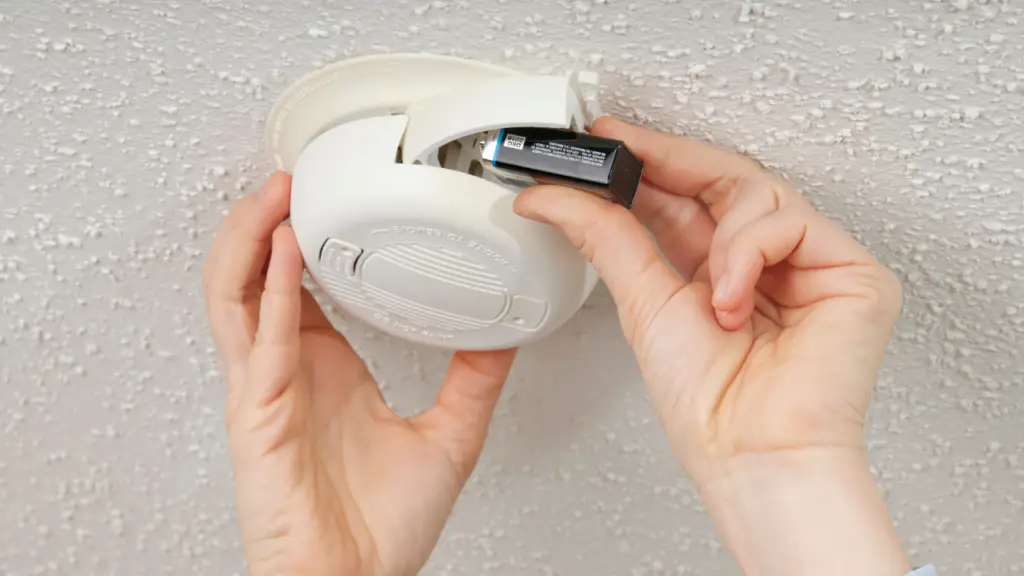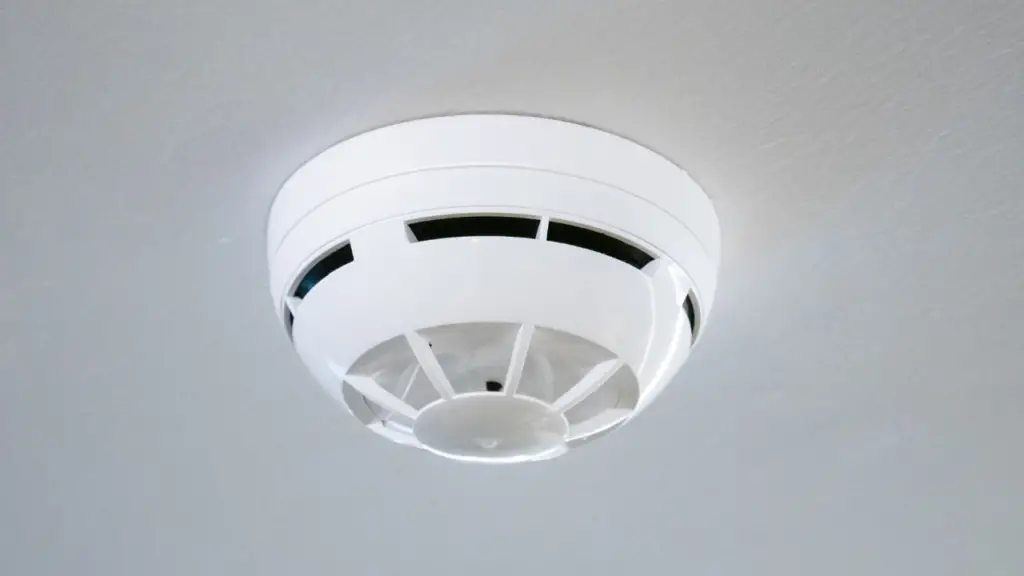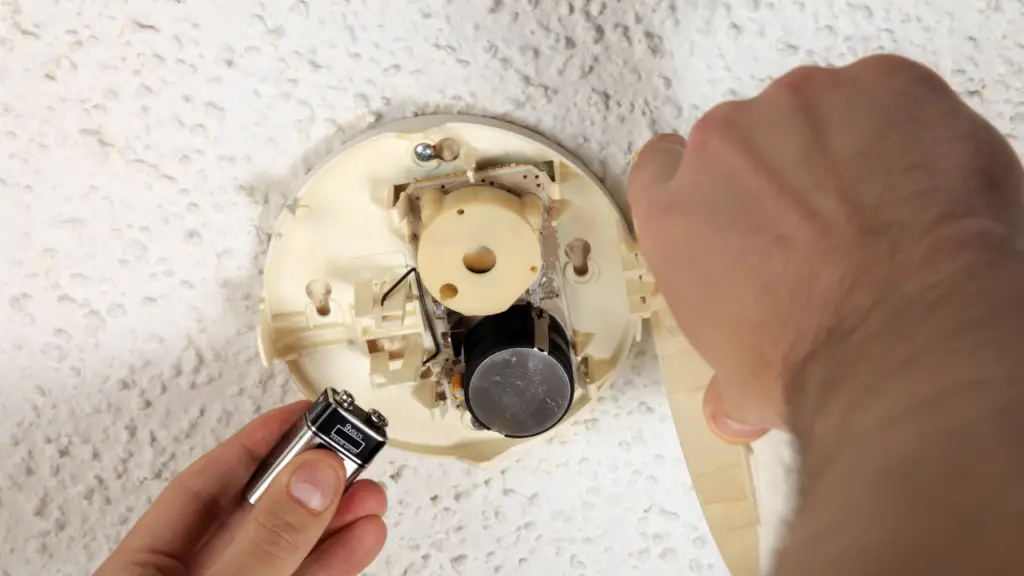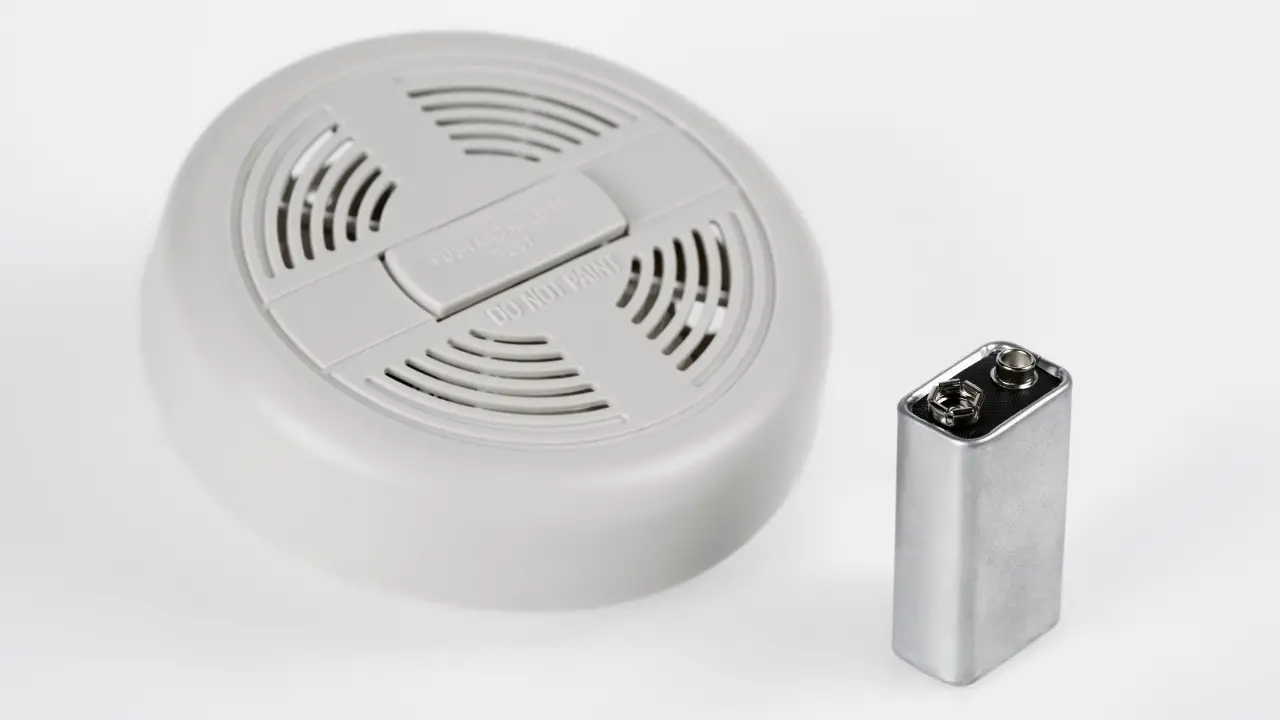Ensure the safety of your home by regularly changing the battery in your smoke detector.
Table of Contents
Key Takeaways:
- Twist, unlock, or open the cover of the smoke detector to access the battery.
- Replace the old battery with a new one, matching the polarity indicated on the device.
- Test the smoke detector after battery replacement to ensure proper functionality.
- Replace the battery twice a year, during the fall and spring, and mark the date of replacement on the inside of the smoke alarm.
- Hard-wired units require yearly replacement of the backup battery for uninterrupted operation.
- Smoke detectors should be replaced every 10 years for optimal performance.
Why Should You Change the Smoke Detector Battery?
Regularly changing the smoke detector battery is crucial for maintaining the effectiveness of the device in alerting you to potential fire hazards. A properly functioning smoke detector can mean the difference between life and death in the event of a fire. Batteries provide the power necessary for the smoke detector to detect smoke particles and emit a loud alarm, giving you and your family enough time to evacuate safely.
Smoke detectors rely on battery power, and without regular replacement, the battery can become weak or die completely, rendering the smoke detector useless. Changing the battery in your smoke detector twice a year, when the clocks change in the fall and spring, ensures that your detector is always ready to detect smoke and provides early warning of a potential fire.
In addition to regular battery replacement, it is also important to test your smoke detector regularly. Testing the detector after battery replacement and on a monthly basis ensures that it is functioning properly. By pressing the test button for a few seconds, you can simulate a smoke detection event and confirm that the alarm sounds. If the alarm doesn’t sound, check the battery connections and try different batteries. If the smoke detector still fails the test, it is recommended to replace it with a new one.
When to Replace Smoke Detector Batteries and Detectors
To ensure optimal performance, it is recommended to replace the smoke detector batteries twice a year, along with the change of the clocks in the fall and spring. This ensures that you start each season with a fresh battery and a properly functioning smoke detector.
In addition to battery replacement, it is important to replace the smoke detector itself every 10 years. Over time, smoke detectors can become less reliable and may not detect smoke as efficiently as they did when they were new. By replacing your smoke detector every 10 years, you can ensure that you have the latest technology and the highest level of fire detection and protection in your home.
By following these guidelines and maintaining a routine schedule for battery replacement and detector replacement, you can have peace of mind knowing that your smoke detector is always ready to protect you and your loved ones from potential fire hazards.
| When to Replace Smoke Detector Batteries | Twice a year |
|---|---|
| When to Replace Smoke Detectors | Every 10 years |

How to Remove the Smoke Detector Cover
Before changing the smoke detector battery, you need to know how to properly remove the cover. Each smoke detector model may have a slightly different method, but here are three common ways:
- Twist the cover: Some smoke detectors have a twist-off cover. To remove it, firmly grip the cover and twist it counterclockwise until it comes off. Be cautious not to force it or break any plastic components.
- Unlock the cover: Other smoke detectors have a plastic lock securing the cover. To open it, use a small flathead screwdriver to press down on the lock tab while simultaneously lifting the cover. Once the lock is released, carefully remove the cover.
- Pop open the cover: For certain smoke detector models, the cover can be easily popped open with your fingers. Locate the small indentation or groove on one side of the cover and apply gentle pressure to release the latch. The cover should then come off effortlessly.
After removing the cover, you will have access to the smoke detector’s battery compartment. Proceed to the next section to learn how to replace the smoke detector battery.
Example of a Smoke Detector Cover Removal
“I followed the instructions to twist the cover, and with a gentle, firm grip, I successfully unscrewed it. The cover came off smoothly, revealing the battery compartment. It was a quick and effortless process.” – John Doe, Homeowner
| Smoke Detector Model | Cover Removal Method |
|---|---|
| Model A | Twist-off cover |
| Model B | Plastic lock |
| Model C | Pop-open cover |
Refer to the table above for different smoke detector models and their corresponding cover removal methods. Always consult the user manual provided by the manufacturer for specific instructions related to your smoke detector model.
Replacing the Smoke Detector Battery
Once the cover is off, it’s time to replace the old battery with a fresh one to ensure the smoke detector stays operational. To do this, follow these steps:
- Remove the old battery from the smoke detector.
- Insert the new battery, making sure the negative and positive connections match the labels in the smoke detector.
- Ensure the battery is securely in place.
Testing the smoke detector after battery replacement is crucial to ensure it is functioning correctly. Locate the test button on the smoke detector and press it for a few seconds to engage the test. If the alarm doesn’t sound, check the battery connections and try different batteries. If the smoke detector fails the test, it is time to replace it.
Replacing the Backup Battery in Hard-Wired Units
For hard-wired smoke detectors with backup batteries, it is essential to replace the backup battery annually. This ensures uninterrupted functionality in case of power outages. To replace the backup battery, follow these steps:
- Locate the backup battery compartment on the smoke detector.
- Open the compartment and remove the old backup battery.
- Insert a new backup battery, following the polarity markings.
- Close the compartment securely.
Remember, regular maintenance of smoke detectors is crucial for home safety. Replace the battery in your smoke detector twice a year, coinciding with the change of the clocks in the fall and spring. Mark the date you changed the battery on the inside of the smoke alarm to keep track. Additionally, it is advisable to replace the entire smoke detector every 10 years for optimal performance.
| Smoke Detector Battery Replacement Checklist |
|---|
| ✓ Remove the cover of the smoke detector. |
| ✓ Replace the old battery with a new one. |
| ✓ Test the smoke detector before re-installing it. |
| ✓ Replace the battery twice a year. |
| ✓ Replace the backup battery in hard-wired units annually. |
| ✓ Replace the smoke detector every 10 years. |

Testing the Smoke Detector
After replacing the battery, it’s essential to test the smoke detector to ensure it is functioning properly. Testing your smoke detector regularly is crucial for the safety of your home and family. Here are the steps to test your smoke detector:
- Locate the test button on your smoke detector. It is usually labeled and easily accessible on the front or side of the unit.
- Press and hold the test button for a few seconds until you hear the alarm sound. This will simulate a smoke detection event and confirm that the detector is operational.
- If the alarm sounds loud and clear, your smoke detector is functioning correctly. The sound should be loud enough to wake you up in case of an actual fire.
- If the alarm doesn’t sound or the sound is weak, check the battery connections and make sure they are secure. Try replacing the battery with a fresh one and test again. If the problem persists, it may be time to replace the smoke detector.
Testing your smoke detector regularly, ideally once a month, will ensure that it is working properly and provide early warning in case of a fire. Remember to follow the manufacturer’s instructions for testing, as different models may have specific requirements. It is better to be safe than sorry when it comes to the safety of your home and loved ones.
| Smoke Detector Testing Checklist |
|---|
| Locate the test button on your smoke detector. |
| Press and hold the test button for a few seconds. |
| Listen for a loud and clear alarm sound. |
| If the alarm is weak or doesn’t sound, check battery connections and try replacing the battery. |
When to Replace Smoke Detector Batteries and Detectors
Knowing when to replace the batteries and the smoke detector itself is crucial for maintaining a safe living environment. The batteries in your smoke detector should be replaced twice a year, coinciding with the change of clocks in the fall and spring. This regular maintenance ensures that your smoke detector is always powered and ready to detect any potential fire hazards.
In addition to battery replacement, it is important to replace the smoke detector itself every 10 years. Over time, smoke detectors may become less reliable or may no longer meet current safety standards. By replacing your smoke detector every decade, you can ensure optimal performance and the highest level of fire detection in your home.
Note: Some newer smoke detectors are equipped with lithium batteries that can last up to ten years. These models provide a longer lifespan for both the battery and the detector, but it is still recommended to replace the smoke detector itself every 10 years for peace of mind.
| Recommended Maintenance Schedule: | Twice a year | Every 10 years |
|---|---|---|
| Battery Replacement | When the clocks change in fall and spring | N/A (lithium battery models may last up to 10 years) |
| Smoke Detector Replacement | N/A | For optimal performance and safety |
By following these guidelines, you can ensure that your smoke detector is always in proper working condition and ready to protect you and your loved ones in the event of a fire.
Marking and Maintaining Battery Replacement Dates
Keeping track of battery replacement dates ensures that you don’t miss the recommended schedule for changing smoke detector batteries. Regular maintenance is crucial to ensure the continued functionality of your smoke detectors and to keep your home safe from potential fires.
Here are some tips for marking and maintaining battery replacement dates:
- Use a permanent marker or label maker to write the date of battery replacement on the inside of each smoke alarm. This will serve as a reminder of when the battery was last changed and when it needs to be replaced.
- Choose a prominent and easily accessible location for marking the dates. It could be on the back of the smoke detector cover or inside the battery compartment.
- If you have multiple smoke detectors in your home, consider creating a schedule or checklist to keep track of each unit’s battery replacement dates. This will help you stay organized and ensure all the detectors are properly maintained.
- Set reminders on your phone or calendar to prompt you when it’s time to change the batteries. This will help you stay on top of the recommended schedule and avoid any lapses in home safety.
Remember, regularly replacing the batteries in your smoke detectors is a simple and effective way to protect your family and property from the dangers of fire.
Table: Recommended Battery Replacement Schedule
| Smoke Detector Type | Battery Replacement Frequency |
|---|---|
| Battery-Powered | Twice a year, when the clocks change in the fall and spring |
| Hard-Wired with Backup Battery | Backup battery should be replaced yearly |
By following these guidelines and maintaining a regular schedule for battery replacement, you can ensure that your smoke detectors are always functioning optimally to provide early warning in the event of a fire. Stay proactive and keep your home safe!

Replacing Backup Battery in Hard-Wired Units
Hard-wired smoke detectors are an essential component of home fire safety systems. These detectors are directly connected to your home’s electrical system, ensuring continuous operation even during power outages. However, it’s important to note that these units also rely on backup batteries to provide power in case of electrical failure. To maintain the effectiveness of your hard-wired smoke detector, regular battery replacement is crucial.
Hard-wired smoke detectors also require backup battery replacement to ensure continuous operation. When replacing the backup battery, follow these steps:
- Locate the smoke detector’s battery compartment. This is usually located on the back or side of the unit.
- Open the battery compartment using a screwdriver or by pressing a small release button.
- Remove the old battery and dispose of it properly according to local regulations.
- Insert a new, fully charged battery into the compartment, ensuring that the positive and negative terminals align with the markings inside the smoke detector.
- Close the battery compartment securely.
Remember, the backup battery in a hard-wired smoke detector should be replaced annually to guarantee uninterrupted functionality. Regularly testing your smoke detector after replacing the backup battery is also important. Press and hold the test button for a few seconds to verify that the detector is functioning correctly. If the alarm does not sound, double-check the battery connections and try a different battery. If the problem persists, it may be necessary to replace the smoke detector itself.
| Smoke Detector Battery Replacement Schedule | Actions |
|---|---|
| Twice a year | Replace the batteries when changing the clocks in the fall and spring. |
| Annually | Replace the backup battery in hard-wired units to ensure continuous operation. |
| Every 10 years | Replace the smoke detector itself to maintain optimal performance. |
By following these guidelines and consistently replacing the backup battery in your hard-wired smoke detector, you can ensure that your home remains protected from the dangers of smoke and fire. Remember, smoke detectors are a crucial part of every household’s safety measures, and regular maintenance is key to their effectiveness.
Conclusion
By following these simple steps and maintaining a regular schedule, you can ensure the effectiveness of your smoke detector in protecting your home from fire hazards.
To change the battery in a smoke detector, start by removing the cover. This can be done by twisting it open, unlocking a plastic lock with a screwdriver, or simply popping it open with your fingers, depending on the model.
Next, replace the old battery with a new one. Make sure to match the negative and positive connections with the labels in the smoke detector. While most smoke detectors use a 9-volt battery, some models use lithium batteries that can last up to ten years.
Before re-installing the smoke detector, it’s crucial to test it. Locate the test button, usually located on the front or side of the unit, and press it for a few seconds to engage the test. If the alarm doesn’t sound, double-check the battery connections and try different batteries. If the smoke detector fails the test, it’s time to replace it.
Remember to replace the battery twice a year, coinciding with the changing of the clocks in the fall and spring. Mark the date you changed the battery on the inside of the smoke alarm to maintain a regular schedule. Additionally, don’t forget to replace the backup battery in a hard-wired unit annually. And keep in mind that smoke detectors should be replaced entirely every 10 years for optimal performance.
FAQ
Q: How often should I change the smoke detector battery?
A: It is recommended to change the smoke detector battery twice a year, when the clocks change in the fall and spring.
Q: Why should I change the smoke detector battery?
A: Regularly changing the smoke detector battery ensures reliable functionality and early detection of potential fires, providing a safer home environment.
Q: How do I remove the smoke detector cover?
A: To remove the smoke detector cover, twist it open, open a plastic lock with a screwdriver, or pop it open with your fingers, depending on the model.
Q: How do I replace the smoke detector battery?
A: To replace the smoke detector battery, remove the old battery and replace it with a new one. Ensure that the negative and positive connections match the labels in the smoke detector.
Q: How do I test the smoke detector?
A: To test the smoke detector, locate the test button and press it for a few seconds. If the alarm doesn’t sound, check battery connections and try different batteries. If it fails the test, replace the smoke detector.
Q: When should I replace smoke detector batteries and detectors?
A: Smoke detector batteries should be replaced twice a year, while the detectors themselves should be replaced every 10 years for optimal performance.
Q: How do I mark and maintain battery replacement dates?
A: Mark the date you changed the battery on the inside of the smoke alarm. This will help you maintain a regular schedule for battery replacement.
Q: How do I replace the backup battery in hard-wired units?
A: To replace the backup battery in hard-wired smoke detectors, follow the specific steps provided by the manufacturer to ensure uninterrupted functionality.











[…] you tired of the constant beeping from your smoke detector? Follow these simple steps to stop the beeping and restore peace in your […]